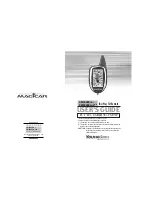
Maintenance
The Lawler thermostatic water controller, if correctly
installed and properly used, should require very little
attention or maintenance. However, every mechanical
device, including water controllers, deserves some care.
Strainers should be checked periodically and, if needed,
cleaned as outlined under “INSPECTING AND CLEANING
OF VALVE.” To test controller for proper setting and
operation—proceed as follows:
1. Place handle in hottest position. Mixing valve should
deliver water at the temperature stamped on the label.
Standard setting is 110°F. If not 110°F, readjust to 110°F
according to “TEMPERATURE ADJUSTMENT” procedure in
another paragraph of this manual.
a. If the temperature is below 110°F and the
following procedures for adjusting do not increase
temperature, see paragraph “CHECKING COLD
WATER SHUT-OFF.”
b. If the temperature is above 110°F and the
following procedures for adjusting do not decrease
temperature, see paragraph “CHECKING HOT
WATER SHUT-OFF.”
Checking Cold Water Shut-Off
1. Turn adjustment handle to cold position. In this position
a full flow of cold water should pass through the
controller.
2. Shut the hot water stop valve and open cold water
stop valve. Cold water should flow momentarily until
thermostat cools and then flow should be reduced to
a negligible amount with adjustment handle set to the
warmest position.
Failure to do so will indicate that:
a. Piston is sticking and unit must be cleaned.
b. Spring has lost its strength and should be replaced.
c. On first test, if water does not flow, this can be
normal if temperature of cold water is below 75°F.
A quick test is to momentarily turn on hot water so
the thermostat warms up. If flow then starts, the
thermostat is good. Failure to obtain flow when first
starting or when valve is cold is a normal reaction.
Checking Hot Water Shut-Off
1. With adjustment handle set in hot position, mixing valve
should deliver water at the temperature stamped on the
nameplate.
2. Shut cold water supply to controller. The hot water
should be reduced to a negligible amount.
Failure to do so will indicate:
a. Hot water supply isn’t 20°F above the required
maximum temperature setting.
b. Piston is sticking. Unit must be cleaned.
c. Thermostat has lost charge.
Performance
The Series 67 will maintain outlet temperature to within
1-1/2°F. under any of the following conditions, providing
the recommended minimum flow and minimum supply
temperature differentials are not exceeded:
• reduction to minimum flow (1 or 1/2 GPM)
• 30°F change in hot water temperature
• 30°F change in cold water temperature
• 50% drop in inlet supply pressure
Maximum Inlet Conditions
Pressure: 125 psig
Temperature: 200°F
Recommended Conditions
Minimum Flow
1 Gallon Per Minute for 67-25
1/2 Gallon Per Minute for 67-10
Minimum Temperature Differential
Hot and cold water inlets must have a minimum 20°F
differential from the outlet set temperature.
Three-Way Protection
Three-Way protection is provided with Lawler’s patented
backseat.
1. Thermostat Protection.
Lawler’s exclusive design cuts water flow if the
thermostat’s liquid motor fails.
2. Hot Supply Protection.
Responds automatically if the hot water supply is
interrupted, or temperature changes.
3. Cold Supply Protection.
Guards against scalding if the cold supply is interrupted.
Lawler Thermostatic Valves adjust for changes in both input
temperature and pressure, maintaining constant output.
Operating Principle
Cold:
With the stop valves open and adjustment handle in
the cold position, the plunger is positioned in the liner so
that the hot ports are closed and the cold ports are open,
allowing only cold water to pass through the controller.
Warm:
When the adjustment handle is moved toward the
warm position, the spring forces the piston upward, opening
the hot water ports and closing the cold water ports. As
the warm water flows over the thermostatic element,
which is solidly filled with a thermo-sensitive liquid, the
liquid changes in temperature. This change in temperature
causes an expansion or contraction of the liquid, resulting
in a movement of the flexible bellows. This movement is
transferred to the pushrod which in turn moves the piston.
This moving action proportions the amount of hot and cold
water allowed to enter the mixing valve in accordance with
the adjustment handle setting.
Содержание 67 Series
Страница 6: ......
























